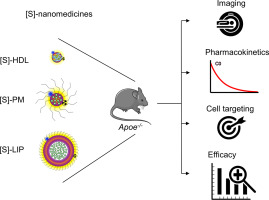A systematic comparison of clinically viable nanomedicines targeting HMG-CoA reductase in inflammatory atherosclerosis
Amr Alaarg, Max L. Senders, Aida Varela-Moreira, Carlos Pérez-Medina, Yiming Zhao, Jun Tang, Francois Fay, Thomas Reiner, Zahi A. Fayad, Wim E. Hennink, Josbert M. Metselaar, Willem J.M. Mulder, Gert Storm
文献索引:10.1016/j.jconrel.2017.07.013
全文:HTML全文
摘要

Atherosclerosis is a leading cause of worldwide morbidity and mortality whose management could benefit from novel targeted therapeutics. Nanoparticles are emerging as targeted drug delivery systems in chronic inflammatory disorders. To optimally exploit nanomedicines, understanding their biological behavior is crucial for further development of clinically relevant and efficacious nanotherapeutics intended to reduce plaque inflammation. Here, three clinically relevant nanomedicines, i.e., high-density lipoprotein ([S]-HDL), polymeric micelles ([S]-PM), and liposomes ([S]-LIP), that are loaded with the HMG-CoA reductase inhibitor simvastatin [S], were evaluated in the apolipoprotein E-deficient (Apoe−/−) mouse model of atherosclerosis. We systematically employed quantitative techniques, including in vivo positron emission tomography imaging, gamma counting, and flow cytometry to evaluate the biodistribution, nanomedicines' uptake by plaque-associated macrophages/monocytes, and their efficacy to reduce macrophage burden in atherosclerotic plaques. The three formulations demonstrated distinct biological behavior in Apoe−/− mice. While [S]-PM and [S]-LIP possessed longer circulation half-lives, the three platforms accumulated to similar levels in atherosclerotic plaques. Moreover, [S]-HDL and [S]-PM showed higher uptake by plaque macrophages in comparison to [S]-LIP, while [S]-PM demonstrated the highest uptake by Ly6Chigh monocytes. Among the three formulations, [S]-PM displayed the highest efficacy in reducing macrophage burden in advanced atherosclerotic plaques. In conclusion, our data demonstrate that [S]-PM is a promising targeted drug delivery system, which can be advanced for the treatment of atherosclerosis and other inflammatory disorders in the clinical settings. Our results also emphasize the importance of a thorough understanding of nanomedicines' biological performance, ranging from the whole body to the target cells, as well drug retention in the nanoparticles. Such systematic investigations would allow rational applications of nanomaterials', beyond cancer, facilitating the expansion of the nanomedicine horizon.
|
Gastroresistant oral peptide for fluorescence imaging of col...
2017-07-19 [10.1016/j.jconrel.2017.07.024] |
|
Chains of magnetosomes with controlled endotoxin release and...
2017-07-13 [10.1016/j.jconrel.2017.07.020] |
|
Diphtheria toxoid and N-trimethyl chitosan layer-by-layer co...
2017-07-11 [10.1016/j.jconrel.2017.07.017] |
|
Drug-eluting embolic microspheres for local drug delivery – ...
2017-07-11 [10.1016/j.jconrel.2017.07.016] |
|
Amelioration of atherosclerotic inflammation and plaques via...
2017-07-11 [10.1016/j.jconrel.2017.07.019] |